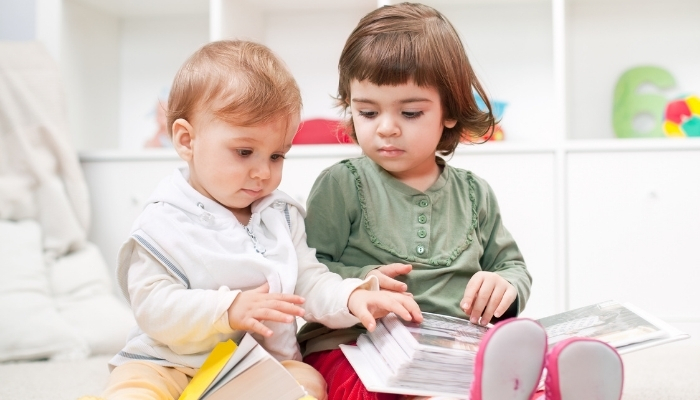Pre-kindergarten reading is a crucial stage that sets the foundation for your child’s future learning. Even before formal reading begins, children can develop essential skills, such as letter recognition, vocabulary, and listening, through playful and engaging activities.
In this blog, we’ll explain the key skills your child should develop before kindergarten, provide practical tips to support reading at home, recommend books, and suggest activities to make learning enjoyable and effective.
Key Takeaways
-
Early reading experiences shape not only literacy skills but also curiosity, problem-solving, and confidence in young learners.
-
Building foundational skills, such as letter recognition, sound awareness, and vocabulary, before kindergarten makes learning smoother.
-
Short, playful, and consistent reading activities at home can create lifelong positive habits around books and language.
-
Choosing the right mix of books and hands-on activities encourages independent exploration and naturally strengthens comprehension.
-
Expert support, like FunFox Readers Club, can guide parents and children through structured, engaging learning while complementing home routines.
What Do You Mean By Pre-Kindergarten Reading and Why Does It Matter?

Pre-kindergarten reading is all the learning your child does before formal reading instruction begins. This stage focuses on building awareness of letters, sounds, and how stories work. Your child learns to connect printed words with spoken language and discovers that books carry messages and stories.
This early phase is about creating positive experiences with books and language. Your child explores pictures, listens to stories, and begins to understand that reading flows from left to right and top to bottom.
Here's why pre-kindergarten reading matters for your child:
-
Creates lifelong learning habits - Children who enjoy books early become eager learners.
-
Builds vocabulary faster - Story time introduces new words naturally.
-
Develops listening skills - Following stories helps children focus and comprehend the material.
-
Strengthens parent-child bonds - Reading together creates memorable moments.
-
Prepares for school success - Children enter kindergarten with confidence.
-
Improves communication skills - Exposure to language patterns helps speech development.
-
Sparks imagination - Stories fuel creativity and curiosity.
These early reading experiences shape how your child approaches learning throughout their educational journey. Children who struggle with reading often face challenges in other subjects as well.
Also Read: How to Make Reading Fun for Kids: 20 Easy Tips
Key Reading Skills Your Child Should Build Before Kindergarten
Before formal learning begins, your child needs basic reading skills to understand stories and feel confident with books. Developing these skills early makes the transition to kindergarten easier.
Here are the essential skills your child should develop:
Letter Recognition and Sound Awareness
Your child needs to recognize letters and connect them to the sounds they hear. This skill forms the backbone of reading success.
-
Start by pointing out letters in your child's name, on signs, and in favorite books.
-
Make letter learning playful through games and songs.
-
Sing the alphabet song while pointing to letters.
-
Create letter hunts around your home, finding the same letter in different places.
-
Use magnetic letters on your refrigerator for hands-on practice.
Sound awareness means understanding that words are made of different sounds. Help your child notice rhyming words in songs and stories. Play simple games like "What sound does 'ball' start with?" Keep it light and fun.
Vocabulary Development and Conversation
Rich conversations expand your child's vocabulary. The more words they know, the easier reading becomes later.
-
Talk about everything you see and do throughout the day.
-
Describe what you're cooking, where you're going, and how things feel or look.
-
Ask your child questions and listen to their responses.
-
Read diverse books with them and introduce new vocabulary naturally.
Don't worry about using "simple" words. Children love learning big, interesting words when you explain them. If you read about elephants, you should talk about their "enormous" size or "wrinkled" skin.
Listening and Comprehension Skills
Listening and comprehension go hand in hand. As your child listens to stories, they learn to follow along and understand what’s happening. These skills help when they start reading on their own. You can build this by asking simple questions, such as “What do you think will happen next?” or “How do you think the character feels?” and letting them tell the story in their own words.
Understanding Print as a Message
This skill helps your child understand that printed words carry meaning and tell stories. Recognizing this is important because it builds the foundation for reading fluency and comprehension.
You can support this by:
-
Point to words as you read, showing that the text tells the story.
-
Let your child see you reading newspapers, recipes, or shopping lists.
-
Show how we read from left to right and top to bottom.
-
Run your finger under words as you read them.
-
Help your child understand that spaces separate different words.
Point out different types of text - signs, labels, books, and letters all carry different messages. This awareness builds print concepts crucial for reading success.
Phonemic Awareness Development
Your child learns to hear and play with individual sounds in words. This skill will help them understand that words can be broken apart and reassembled. Start with simple activities, such as clapping syllables in their name or favorite words.
Play games where you stretch out sounds in short words. Say "c-a-t" slowly and ask your child what word you made. Then let them try stretching out simple words, too. This will build the foundation for sounding out words later.
Basic Phonics Foundation
Your pre-kindergartener begins connecting letters with their most common sounds. Focus on the letters in their name first, then add a few simple, frequently used letters like ‘m’, 's', and 't'.
Don't worry about teaching all letter sounds at once. Your child needs lots of time to master just a few sounds before adding more. Make it playful by saying, "The letter 'M' says 'mmm' like mommy!"
Use everyday objects to reinforce letter-sound connections. These natural connections will help your child remember sounds better than formal lessons.
It's essential to develop strong foundational reading skills that work together to create confident, capable readers ready for kindergarten success.
Tips and Techniques to Support Pre-Kindergarten Reading at Home

You can play a key role in building your child’s reading skills before kindergarten. Simple, everyday activities help them recognize letters, understand sounds, and enjoy stories while developing vocabulary, comprehension, and confidence. Building a consistent reading routine at home now will set the foundation for lifelong learning.
-
Set up a cozy reading space where your child feels comfortable exploring books. This could be a corner with pillows, a special chair, or even a blanket fort. Make books easily accessible at your child's eye level.
-
Read aloud every single day, even if it's just for 10-15 minutes. Consistency builds habits and shows your child that reading is important. Choose times when you're both relaxed and can focus together.
-
Let your child choose books that interest them, even if they seem too easy or you've read them many times. Following their interests keeps them engaged and excited about reading.
-
Make voices and sound effects while reading to bring stories to life. Your animated reading captures your child's attention and makes stories memorable. Don't worry about sounding silly - children love dramatic storytelling.
-
Ask open-ended questions about the story to encourage thinking. "What do you notice on this page?" or "How would you solve this problem?" These questions develop critical thinking skills.
-
Point to words occasionally as you read, but don't make it the focus. This helps your child connect spoken and written language without turning story time into a lesson.
-
Encourage pretend reading by having your child "read" familiar books by looking at pictures and retelling the story. This builds confidence and shows they understand how stories work.
-
Be patient with mistakes and focus on effort rather than perfection. If your child mispronounces a word, gently provide the correct pronunciation without making it feel like a correction.
These simple techniques foster positive associations with reading and naturally build skills through enjoyable experiences.
Also Read: Kindergarten Reading Level Guide and Tips
Now that you know how to support your child at home, it's time to look at what kinds of books you can do it with.
Best Books to Build Reading Skills in Preschoolers and Pre-Kindergarteners
Choosing the right books makes reading time more engaging and educational for your child. Different types of books serve different purposes in building reading skills. Mix various categories to give your child a well-rounded reading experience that develops multiple skills simultaneously.
Here is a compiled list of books to choose from:
Picture Books
-
The Truck Cat by Frenkel & Snell
-
Hairy Maclary series by Dodd
-
Good Hair by Sewankambo & Chiu
-
Squish Rabbit by Battersby
-
Naughty Agapanthus by Macfarlane
-
Olivia series by Falconer
-
The Garden of Broken Things by Blackwood
-
Bernie Thinks in Boxes by Horn & Bennett
-
Hide & Seek Beautiful by Esler Gill & Robaard
-
Reading to Baby by Wild & Sommerville
Rhyming & Phonological Awareness Books
-
Possum Magic by Mem Fox
-
Digger Digs Down by Bell & Bolliger
-
Dinosaur in My Pocket by Barton & Fielden
-
Lights Out, Little Dragon! by Tidball & Tan
-
An Australian 1, 2, 3 of Animals by Bancroft
-
The Very Hungry Caterpillar by Carle
-
Over or Under? by Harry & Tapper
Alphabet, Concept & Counting Books
-
An Australian ABC of Animals by Bancroft
-
A is for Australia by Lessac
-
One Little Duck by Germein & Snell
-
Ten Apples Up On Top! by Dr. Seuss
Storybooks on Feelings, Family & Everyday Life
-
Me and My Dad by Morgan & Kwaymullina
-
Maddy's First Day by Matthews
-
Let's Get a Pup by Graham
-
Owl Babies by Waddell
-
Alexander and the Terrible, Horrible, No Good, Very Bad Day by Viorst
-
Za-Za's Baby Brother by Cousins
-
When Billy Was a Dog by Murray
-
Before We Met by Tozer & Beer
-
To Stir With Love by Mildenhall & Racklyeft
-
Our Library by Rawlins
-
Listen, Hippo by Evans
-
Yanga Mother by Leavy & Bassi
Books About the World and Nature
-
Footprint by Cumming & Han
-
Amid the Sand Dunes by Rowe & Sommerville
-
Are We There Yet? by Lester
-
The Early Learning Big Book of Australian Nature by Parish
Multicultural, Diversity & Social Themes
-
Yanga Mother by Leavy & Bassi
-
Good Hair by Sewankambo & Freda Chiu
-
Bernie Thinks in Boxes by Horn & Bennett
These books will make sure that your child experiences a range of stories while developing essential pre-kindergarten reading skills. Remember to follow your child's interests and let them guide book choices whenever possible.
Also Read: Effective Oral Reading Fluency Interventions and Strategies for Young Readers
List of Activities to Introduce Reading for Preschoolers

Fun activities help your preschooler explore books and letters without pressure. These simple games build early skills while feeling like play. Remember, children this age learn best through hands-on exploration and repetition.
Keep activities very short - 5 to 10 minutes is perfect for this age group. Follow your child's interest and stop when they seem tired or distracted.
Sing Letter Songs
Teach your child simple alphabet songs while doing actions or clapping. Start with just a few letters at a time, especially the letters in their name. Make up silly songs like "B says 'buh' for ball and bear."
Use your hands to make letter shapes in the air while singing. This helps your child connect the letter shape with its sound. Don't worry about singing perfectly - your child loves hearing your voice.
Repeat favorite letter songs during car rides or while waiting. The repetition helps your pre-kindergartener remember letters naturally without feeling like they're studying.
Look and Find Games
Play simple games where you look for familiar things in picture books together. "Can you find the cat?" or "Where is something red?" keeps your child engaged while building observation skills.
Start with very obvious things in pictures, then gradually look for more minor details. This activity builds the visual skills your child needs for reading while making book time interactive and fun.
Let your child point to things they notice, even if it's not what you asked them to find. Their discoveries are just as valuable and keep them interested in exploring books.
Make Letter Shapes with Bodies
Help your child make letter shapes using their whole body. They can stretch their arms up high for the letter "I" or curve into a "C" shape. This physical movement helps them remember how letters look.
Start with simple, straight letters like "I," "L," and "T" before trying curved letters. Make it silly and fun - your child might wiggle while making an "S" or hop while being the letter "I."
Take pictures of your child making different letter shapes. They'll love seeing themselves as letters, and it reinforces the shapes in a memorable way.
Story Time with Stuffed Animals
Set up a circle with your child's favorite stuffed animals and "read" to the whole group. Your pre-kindergartener can help turn pages or point to pictures while you read aloud to the audience.
Let your child be the teacher sometimes, holding the book and telling the story to their stuffed friends. They don't need to read real words; they're learning how books work and building confidence. This activity makes story time social and special.
Texture Letter Exploration
Create letters using various textures, such as sandpaper, cotton balls, or aluminum foil. Let your child trace the textured letters with their finger while saying the letter name and sound.
Start with the letters in your child's name since these are most meaningful to them. The different textures help their brain remember letter shapes through touch as well as sight.
Make this a craft activity by gluing different materials onto cardboard letter shapes. Your child helps create the learning materials, making them more invested in using them.
Picture Storytelling
Look through family photos or picture books without words and encourage your child to tell you what's happening. "What do you think this person is doing?" helps build storytelling skills.
Don't worry about logical stories - let your pre-kindergartener's imagination run wild. They're learning that pictures can tell stories and developing the language skills they'll need for reading comprehension.
Ask simple questions that encourage more talking: "Then what happened?" or "How do you think they felt?" These conversations build vocabulary and thinking skills.
Daily Print Awareness Walks
Take short walks around your neighborhood or home, pointing out letters and signs together. "Look, there's an 'S' on that stop sign!" makes letters feel important and everywhere.
Focus on just one or two letters per walk, especially letters your child knows well. Too many letters at once can overwhelm a pre-kindergartner who's still learning to recognize letters.
Make it a game by giving your child a special job: "You're the letter detective! Can you spot any letter 'B's?" This keeps them engaged while building letter recognition skills.
Simple Rhyming Play
Play with words that sound alike during everyday activities. "Your socks and rocks both end the same way!" helps your child hear sound patterns without formal lessons.
Use their name to create silly rhymes: "Katie, shatie, batie!" Children this age love nonsense words and don't need perfect rhymes to develop sound awareness.
Sing simple nursery rhymes and pause before rhyming words so your child can fill in the blanks. "Twinkle, twinkle little..." and wait for them to say "star." Keep it playful and pressure-free.
These gentle activities introduce reading concepts while keeping learning fun and age-appropriate for your pre-kindergartener's developmental stage.
How to Support Children Who Find Reading Hard?

Some children require additional support and varied approaches to develop their reading skills. This doesn't mean they're not intelligent or capable; every child learns at their own pace and in their own way. You can provide gentle, consistent support that builds confidence while addressing specific challenges.
-
Use multi-sensory learning approaches that engage different senses simultaneously. Let your child trace letters in sand, build them with play-dough, or write them in the air. These physical movements help the brain remember letters and sounds better.
-
Break skills into smaller steps to avoid overwhelming your child. Instead of learning all 26 letters at once, focus on 2-3 letters for several weeks. Master these completely before adding new ones.
-
Provide extra repetition without making it feel like drilling. Read the same book multiple times, play the same letter game regularly, and revisit familiar activities. Repetition helps build the neural pathways necessary for reading success.
-
Focus on your child's strengths while gently working on challenging areas. If your child loves art, use drawing and coloring to practice letters. If they love music, use songs and rhymes to build sound awareness.
-
Create positive associations with reading by avoiding forced or pressured situations. If your child resists an activity, try a different approach or take a break. Keep reading time enjoyable and stress-free.
-
Celebrate small victories enthusiastically. If your child recognizes one letter correctly, make a big deal about it. These celebrations build confidence and motivation to keep trying.
-
Use assistive techniques, such as pointing to words while reading or using a bookmark to track lines. These supports help children focus without making them feel like they're failing.
-
Consider a professional evaluation if you have ongoing concerns. Speech therapists, educational specialists, or pediatricians can identify specific issues and recommend targeted strategies.
-
Connect with your child's future teachers to share what works at home. Consistent approaches between home and school provide the best support for children who struggle.
-
Maintain realistic expectations based on your child's individual development timeline. Some children aren't ready for formal reading skills until age 6 or 7, and that's perfectly normal.
Remember that your love, patience, and consistent support matter more than perfect execution of any technique. Children who struggle with reading need extra encouragement, not extra pressure.
Also Read: How to Improve Reading Fluency in Dyslexic Students?
How FunFox's Reading Club Can Support Your Child's Pre-Kindergarten Reading Journey?
Many parents struggle to find the right balance between daily responsibilities and supporting their child’s early reading development. Sometimes children resist reading at home or don’t respond to guidance, leaving parents unsure how to help. This is where FunFox’s Readers Club makes a difference, providing expert support tailored to young learners.
Why parents trust FunFox:
-
Convenient online classes: Learn from home without travel, making consistent reading practice easier to fit into busy schedules.
-
Small batches: Classes of 3-6 children ensure personalized attention, helping each child build confidence and self-esteem.
-
Expert teachers: FunFox-trained educators use targeted strategies to develop phonological awareness, vocabulary, and comprehension.
-
Peer involvement: Learning alongside classmates motivates children and builds social skills.
-
Flexible access: Live lessons with recorded sessions allow children to revisit key concepts later.
FunFox transforms early reading support into a structured, engaging journey that prepares children for kindergarten success, while providing parents with guidance they can trust.
Conclusion
Pre-kindergarten reading builds the foundation for your child's lifelong learning. Skills like letter recognition, vocabulary, and listening comprehension will set them up for success in school and beyond.
Daily reading, rhyming games, and hands-on activities can naturally strengthen these skills. Every child develops at their own pace, and your consistent support gives them the confidence and curiosity to learn.
FunFox Readers Club can complement your efforts with small, expert-led online classes that make early reading engaging and effective.
Give your child a strong start. Book a trial session with FunFox Readers Club today.
FAQ’s
1. How to teach reading in pre-K?
Engage children with playful activities like storytelling, letter games, and sound recognition exercises. Encourage curiosity, ask questions about books, and celebrate attempts to build early reading confidence and interest.
2. Which is the best method of reading?
A balanced approach works best, combining phonics, sight words, and comprehension activities to achieve optimal results. Tailor methods to your child’s learning style, making lessons interactive, enjoyable, and connected to real-life experiences.
3. What is the 3-finger rule for reading?
The 3-finger rule helps children select books that match their level. If more than three words on a page are unknown, the book may be too difficult for independent reading.
4. What age is considered an early reader?
Children aged around 5 to 7 years typically qualify as early readers. They start decoding simple texts, recognizing familiar words, and showing growing comprehension and reading fluency skills.















